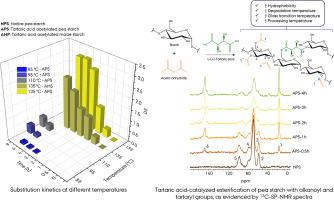Carbohydrate Polymers ( IF 11.2 ) Pub Date : 2022-06-27 , DOI: 10.1016/j.carbpol.2022.119780 Natalia P Vidal 1 , Wenqiang Bai 2 , Mingwei Geng 3 , Mario M Martinez 2

|
Organocatalytic acetylation of pea starch was systematically optimized using tartaric acid as catalyst. The effect of the degree of substitution with alkanoyl (DSacyl) and tartaryl groups (DStar) on thermal and moisture resistivity, and film-forming properties was investigated. Pea starch with DSacyl from 0.03 to 2.8 was successfully developed at more efficient reaction rates than acetylated maize starch. Nevertheless, longer reaction time resulted in granule surface roughness, loss of birefringence, hydrolytic degradation, and a DStar up to 0.5. Solid-state 13C NMR and SEC-MALS-RI suggested that tartaryl groups formed crosslinked di-starch tartrate. Acetylation increased the hydrophobicity, degradation temperature (by ~17 %), and glass transition temperature (by up to ~38 %) of pea starch. The use of organocatalytically-acetylated pea starch with DSacyl ≤ 0.39 generated starch-based biofilms with higher tensile and water barrier properties. Nevertheless, at higher DS, the incompatibility between highly acetylated and native pea starches resulted in a heterogenous/microporous structure that worsened film properties.
中文翻译:

豌豆淀粉的有机催化乙酰化:烷酰基和酒石芳基对淀粉乙酸酯性能的影响
以酒石酸为催化剂系统优化了豌豆淀粉的有机催化乙酰化。研究了烷酰基(DS酰基)和酒石芳基(DS tar )的取代度对耐热性和耐湿性以及成膜性能的影响。DS酰基从 0.03 到 2.8 的豌豆淀粉以比乙酰化玉米淀粉更有效的反应速率成功开发。然而,较长的反应时间会导致颗粒表面粗糙、双折射损失、水解降解和高达 0.5的 DS焦油。固态13C NMR和SEC-MALS-RI表明酒石芳基形成交联的酒石酸二淀粉。乙酰化提高了豌豆淀粉的疏水性、降解温度(约 17 %)和玻璃化转变温度(高达约 38 %)。使用 DS酰基 ≤ 0.39 的有机催化乙酰化豌豆淀粉可生成具有更高拉伸和防水性能的淀粉基生物膜。然而,在较高的 DS 下,高度乙酰化和天然豌豆淀粉之间的不相容性导致了异质/微孔结构,从而使薄膜性能恶化。


























 京公网安备 11010802027423号
京公网安备 11010802027423号